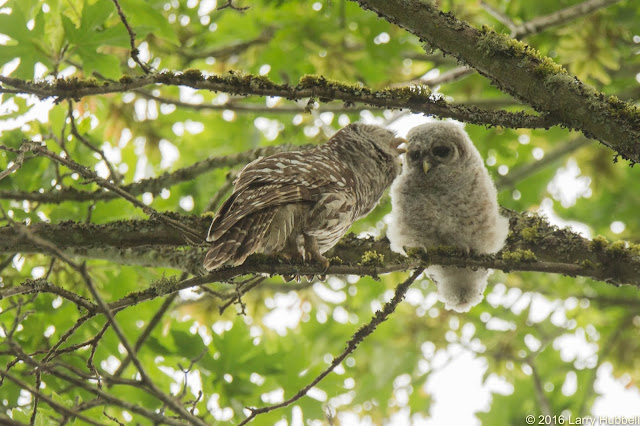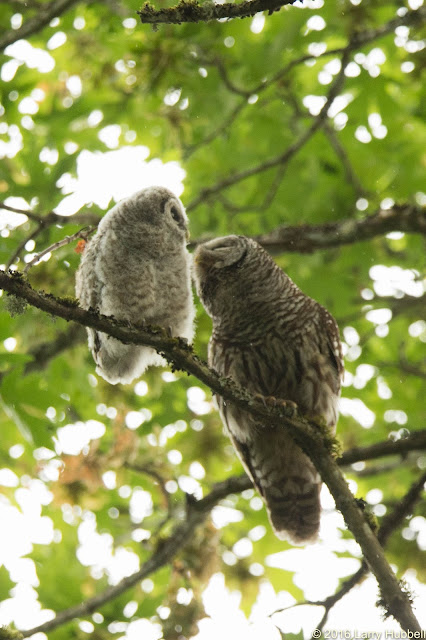I find it impossible to look at a barred owl and not be impressed. There is the perfect symmetry and balance. There is the way every feather aligns. Each individual feather is a work of art and all together they form a masterpiece.
Each feather has multiple functions. Plus, they usually belong to a set of feathers with a group purpose as well. There are primary, secondary and tertiary flight feathers. There are multiple types of coverts. Wing coverts cover the base of the flight feathers, both above and below the wing, which helps to keep the airflow smooth and unperturbed. There are similar tail coverts. The upper ones are visible in this photo. Each owl must have hundreds of feathers. In addition to aerodynamics, warmth and camouflage, facial feathers help the owl to hear the smallest sound, while unique wing feathers allow the owl to glide in virtual silence.
With a shudder, an owl can raise most of its feathers at once. I wonder if the purpose is to add air and retain body warmth, or to realign the feathers, or both.
In nature, it seems like nothing is ever done for just a single purpose.
A critical portion of the owl's time is spent maintaining its feathers.
The beak closes over each side of the base of the feather, then as the owl pulls away from its body the interlocking barbs and barbules become perfectly realigned.
Maintaining their feathers is not always a solitary practice.
Allo-preening may communicate intentions beyond grooming in both mammals and birds.
Scientists caution us about ascribing human intentions and emotions to other creatures. It can cause us to misunderstand the behaviors we see.
By the way, given that males are slightly smaller than females, I believe the bird on the left is the male.
It is interesting how genetic research seems to be showing that we have a shared heritage with all life on earth.
It makes me wonder if scientists will someday discover that behaviors which we share with other creatures have a common genetic basis.
Either way, it can be hard to ignore the feelings that other creatures evoke in us.
Especially when we see an adult caring for its offspring.
When the young bird takes a turn at grooming the parent, it certainly makes me think this may be an instinctual behavior. Have you ever wondered if we have instinctual behaviors?
If you read last week's post, Flight Risk, about Dizzy Dean and Prudence then you will understand when I say that I suspect this young bird is Prudence. Either way, this photo shows the young bird just two days after it left the nest.
I wonder if this particular motion has to do with grooming or the young bird's desire to be fed or something else which I have yet to comprehend.
Clearly the parent appears focused on the grooming.
Have you ever felt like someone was getting just a little too close?
Sometimes there comes a moment when you realize you need a little elbow room.
If you have ever had a child in kindergarten or grade school, you may have noticed that some parents tend to hover rather close to their children.
When the child pulls away, they just move a little closer.
Some parents can be a bit slow to get the hint.
The budding signs of independence are easily ignored.
On the other hand, until you become a parent, you can never really understand what it means to be invested.
It is hard to blame a parent for caring.
In the end, every child must learn to go it alone. It is only a question of time.
I do believe that keeping an open mind is critical to the process of scientific discovery. Observing wild creatures can teach us a lot. Watching wildlife can also help to stay us mentally and physically healthy, even if we are not scientists.
Sometimes I do wonder if anthropomorphizing may be the lesser of two evils. Paying attention to the feelings which the creatures around us evoke and knowing how much we share in common may actually motivate us to do more to protect them.
Have a great day on Union Bay...where nature lives in the city!
Larry




























Your pictures and stories help to remind us that all animals have families and feelings just as we do. We should observe only and give them room to develop and live. We have taken so much of their natural habitat.
ReplyDeleteThank you for caring about the creatures around us. In this era of a human dominated world, I think of pavement as the opposite of life. It is not that we kill so many wild creatures outright, its that we remove their source of sustenance.
DeleteI'm trying hard not to like Barred Owls, but you make it more difficult with these captivating photos!
ReplyDeleteIt is an odd situation with the barred owls displacing the spotted owls and at the same time the barred owls are adapting and living in city parks which is certainly better than not having owls. I am thinking the best approach is to appreciate all life while attempting to help retain as much diversity as possible. I admit I am conflicted about the shooting of barred owls in California in an attempt to save the spotted owls. I can see both sides of the issue.
DeleteYou might want to read Carl Safina's book Beyond Words: What Animals Think and Feel and/or Zoobiquity by Barbara Horowitz for more on our shared emotions and biology with animals. Love your blog and am a faithful reader. Remember parenting together?
ReplyDeleteThank you for your recommendations and for following along! Yes, I do remember those days as parents and the optimistic, bountiful energy of our children. I do not think we realized how young we were at the time. Every day is a gift.
DeleteBrilliant photography along with with wise observations on nature, life and parenting. This is so good.
ReplyDeleteThank you! You are very kind. I am sure you also found parenting the greatest challenge and the most rewarding part of life.
DeleteI don't think it's so wrong to ascribe human emotions to animals. After all, as humans the only emotions we can understand for certain are our own. Why not use that as a basis to empathize with our animal friends. What is the alternative, coldly claiming that animals don't feel anything? Love your photos. My husband is an owl lover and met you in the park the other night. Thanks for sharing.
ReplyDeletePersonally, I find it impossible not to see emotions and emotional behavior in the creatures I am watching, but I also want to be open to other possible interpretations of their motivations.
DeleteIt was great to meet your husband and spend time searching for the owls. :-)
DeleteDelightful. Thank you.
ReplyDelete